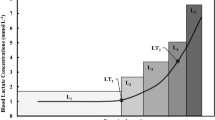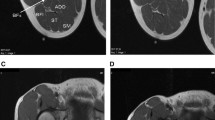Summary
In excised, curarized and massively stimulated fast-twitch mouse gastrocnemius muscles the early twitch tension enhancements (treppe) during 1/s activity between 10 and 36°C increase and affect more contractions as temperature increases. Tension output eventually declines at a temperature-independent rate. Half-relaxation time lengthens below 25°C and shortens above 25°C. During 1/0.63 s twitches half-relaxation time lengthens even at 25°C. In slow-twitch soleus muscles activity decreases twitch tension and half-relaxation time regardless of temperature. Activity shortens contraction times in both muscles. Oxygen lack induced by NaN3 cannot account satisfactorily for these results. Activation is apparently more plastic in the gastrocnemius than in the soleus, and the relationship between the rates of their activation and relaxation processes and the temperature sensitivities of these rates also seem to differ.
In both muscles caffeine can convert activity-induced shortening of half-relaxation times into prolongations. In the soleus this effect is more pronounced at 30 than at 25°C. At high temperature and twitch rates caffeine reduces treppe amplitude and duration without affecting the eventual twitch tension decline in the gastrocnemius while it greatly accelerates twitch tension decline in the soleus. In both muscles intrafiber Ca2+ movements are apparently major determinants of fatigue behavior.
Similar content being viewed by others
References
Bezanilla, F., Caputo, C., Gonzales-Serratos, H., Venosa, R. A.: Sodium dependence of the inward spread of activation in isolated twitch muscle fibers of the frog. J. Physiol. (Lond.)223, 507–523 (1972)
Bianchi, C. P.: Kinetics of radiocaffeine uptake and release in frog sartorius. J. Pharmacol. exp. Ther.138, 41–47 (1962)
Brown, D. E. S., Sichel, F. J. M.: Isometric contraction of isolated muscle fibers. J. cell. comp. Physiol.8, 315–328 (1936)
Brust, M.: Effects of inhibitors on contractions of normal and dystrophic mouse muscles. Amer. J. Physiol.206, 1036–1042 (1964a)
Brust, M.: Changes in contractility of frog muscle due to fatigue and inhibitors. Amer. J. Physiol.206, 1043–1048 (1964b)
Brust, M.: Contraction enhancement in skeletal muscles of normal and dystrophic mice. Amer. J. Physiol.208, 425–430 (1965)
Brust, M.: Relative resistance to dystrophy of slow skeletal muscle of the mouse. Amer. J. Physiol.210, 445–451 (1966)
Brust, M.: Agents which affect excitation-contraction couppling in normal and dystrophic muscle. Fed. Proc.28, 1649–1656 (1969)
Brust, M.: Effects of temperature and twitch rate on fatigue in fast and slow mouse muscles. Proc. Int. Union Physiol. Sci.,IX, XXV. Int. Congr., p. 87 (1971)
Brust, M., Cosla, H. W.: Contractility of isolated human skeletal muscle. Arch. Phys. med. Rehabil.48, 543–555 (1967)
Brust, M., Toback, S., Benton, J. G.: Some effects of ultrasound and of temperature on contractions of isolated mammalian skeletal muscle. Arch. Phys. med. Rehabil.50, 677–694 (1969)
Burke, R. E., Levine, D. N., Salcman, M., Tsairis, P.: Motor units in cat soleus muscle: physiological, histochemical and morphological characteristics. J. Physiol. (Lond.)238, 503–514 (1974)
Burke, R. E., Tsairis, P.: The correlation of physiological properties with histochemical characteristics in single muscle units. Ann. N. Y. Acad. Sci.228, 145–158 (1974)
Close, R.: Dynamic properties of fast and slow skeletal muscles of the rat during development. J. Physiol. (Lond.)173, 74–95 (1964)
Close, R. I.: Dynamic properties of mammalian skeletal muscles. Physiol. Rev.52, 129–197 (1972).
Close, R. I.: The relation between sarcomere length and characteristics of isometric twitch contractions of frog sartorius muscle. J. Physiol. (Lond.)220, 745–762 (1972)
Close, R., Hoh, J. F. Y.: The after-effects of repetitive stimulation on the isometric twitch contraction of rat fast skeletal muscle. J. Physiol. (Lond.)197, 461–477 (1968)
Close, R., Hoh, J. F. Y.: Influence of temperature on isometric contractions of rat skeletal muscles. Nature (Lond.)217, 1179–1180 (1968)
Davies, R. E., Goldspinck, G., Larson, R. E.: ATP utilization by fast and slow muscles during the development and maintenance of isometric tension. J. Physiol. (Lond.)206, 28P-29P (1970)
Desmedt, J. E., Hainaut, K.: Kinetics of myofilament activation in potentiated contraction: staircase phenomenon in human skeletal muscle. Nature (Lond.)217, 529–532 (1968)
Ebashi, S., Endo, M.: Calcium ion and muscle contraction. Progr. Biophys. molec. Biol.18, 123–183 (1968)
Eberstei, A., Sandow, A.: Fatigue in phasic and tonic fibers of frog muscle. Science134, 383–384 (1961)
Eberstein, A., Sandow, A.: Fatigue mechanisms in muscle fibers. In: Effects of use and disuse on neuromuscular functions (E. Gutmann, ed.), pp. 515–526. Prague: Publication House Czechoslovak Acad. Sci. 1963
Feinstein, M. B.: Inhibition of caffeine rigor and radiocalcium movements by local anesthetics in frog sartorius muscle. J. gen. Physiol.47, 151–172 (1963)
Ford, L. E., Podolsky, R. J.: Calcium uptake and force development by skinned muscle fibers in EGTA buffered solutions. J. Physiol. (Lond.)223, 1–19 (1972a)
Ford, L. E., Podolsky, R. J.: Intracellular calcium movements in skinned muscle fibers. J. Physiol. (Lond.)223, 21–33 (1972b)
Gibbs, C. L., Gibson, W. R.: Energy production of rat soleus muscle. Amer. J. Physiol.223, 864–871 (1972)
Grabowski, W., Lobsiger, E. A., Lüttgau, H. C.: The effect of repetitive stimulation at low frequencies upon the electrical and mechanical activity of single muscle fibers. Pflügers Arch.334, 222–239 (1972)
Gutmann, E., Hanzliková, V.: Contracture responses of fast and slow mammalian muscles. Physiol. bohemoslov.15, 404–414 (1966)
Hanson, J.: The effects of repetitive stimulation on the action potential and the twitch of rat muscle. Acta physiol. scand.90, 387–400 (1974)
Hanson, J., Persson, A.: Changes in action potential and contraction of isolated frog muscle after repetitive stimulation. Acta physiol. scand.81, 340–348 (1971)
Hasselbach, W., Weber, A.: Models for the study of the contraction of muscle and cell protoplasm. Pharmacol. Rev.7, 97–117 (1955)
Hellam, D. C., Podolsky, R. J.: Force measurements in skinned muscle fibers. J. Physiol. (Lond.)200, 807–819 (1969)
Horowicz, P., Gerber, C. J.: Effects of sodium azide on sodium fluxes in frog striated muscle. J. gen. Physiol.48, 515–525 (1965)
Isaacson, A., Hinkes, M. J., Taylor, S. R.: Contracture and twitch potentiation of fast and slow muscles of the rat at 20 and 37°C. Amer. J. Physiol.218, 33–41 (1970)
Mainwood, G. W., Lucier, G. E.: Fatigue and recovery in isolated frog sartorius muscles: the effects of bicarbonate concentration and associated potassium loss. Canad. J. Physiol. Pharmacol.50, 132–142 (1972)
Mainwood, G. W., Worsley-Brown, P.: The effects of extracellular pH and buffer concentration on the efflux of lactate from frog sartorius muscle. J. Physiol. (Lond.)250, 1–22 (1975)
Mostofsky, D., Sandow, A.: High-output dual pulse electronic stimulator for physiologic purposes. Electronics24, 114–117 (1951)
Novotný, I., Vyskočil, F., Vycklický, L., Beránek, R.: Potassium and caffeine induced increase of oxygen consumption in frog muscle and its inhibition by drugs. Physiol. bohemoslov.11, 277–284 (1962)
Pellegrino, C., Franzini, C.: Electron microscope study of denervation atrophy in red and white skeletal muscle fibers. J. Cell Biol.17, 327–349 (1963)
Podolsky, R. J., Teichholz, L. E.: The relation between calcium and contraction kinetics in skinned muscle fibers. J. Physiol. (Lond.)211, 19–35 (1970)
Ranvier, L.: Leçons D'Anatomie Generale sur le Système Musculaire, pp. 202–219. Paris 1880
Ritchie, J. M., Wilkie, D. R.: The effect of previous stimulation on the active state of muscle. J. Physiol. (Lond.)130, 488–496 (1955)
Ross, S. M., Brust, M.: Transistorized pulse amplifier for massive stimulation of muscle. J. appl. Physiol.20, 354 (1965)
Rossbach, M. J., Harteneck, K.: Muskelversuche an Warmblütern. II. Ermüdung und Erholung des lebenden Warmblütermuskels. Pflügers Arch.15, 1–11 (1877)
Sandow, A.: Latency relaxation and theory of muscular mechano-chemical coupling. Ann. N. Y. Acad. Sci.47, 895–929 (1947)
Sandow, A.: Excitation-contraction coupling in skeletal muscle. Pharmacol. Rev.17, 265–320 (1965)
Sandow, A., Brust, M.: Contractility of dystrophic mouse muscle. Amer. J. Physiol.194, 557–563 (1958)
Sandow, A., Brust, M.: Effects of activity on contractions of normal and dystrophic mouse muscles. Amer. J. Physiol.202, 815–820 (1962)
Sandow, A., Taylor, S. R., Preiser, H.: Role of the action potential in excitation-contraction coupling. Fed. Proc.24, 1116–1123 (1965)
Saslow, G.: Oxygen consumption and respiratory quotient of caffeinized frog muscles. J. cell. comp. Physiol.10, 385–394 (1937)
Tomanek, R. J., Asmundson, C. R., Cooper, R. R., Barnard, R. J.: Fine structure of fast-twitch and slow-twitch guinea pig muscle fibers. J. Morph.139, 47–66 (1973)
Weber, A.: Energized calcium transport and relaxing factors. In: Current topics in bioenergetics. vol. 1 (D. R. Sanadi, ed.), pp. 203–254. New York-London: Academic Press 1966
Weber, A.: The mechanism of action of caffeine on sarcoplasmic reticulum. J. gen. Physiol.52, 760–772 (1968)
Weber, A., Herz, R.: The relationship between caffeine contracture of intact muscle and the effect of caffeine on reticulum. J. gen. Physiol.52, 750–759 (1968)
Weber, A., Murray, J. M.: Molecular control mechanisms in muscle contraction. Physiol. Rev.53, 612–673 (1973)
Wells, J. B.: Comparison of mechanical properties between slow and fast mammalian muscles. J. Physiol. (Lond.)178, 252–269 (1965)
Winegrad, S.: the intracellular site of calcium activation of contraction in frog skeletal muscle. J. gen. Physiol.55, 77–88 (1970)
Wuerker, R. B., McPhedran, A. M., Henneman, E.: Properties of motor units in a heterogeneous pale muscle (M. gastrocnemius) of the cat. J. Neurophysiol.28, 85–99 (1965)
Author information
Authors and Affiliations
Additional information
This work was partly supported by a grant of the Vocational Rehabilitation Administration, U.S. Department of Health, Education and Welfare, and by research funds of the Departments of Rehabilitation Medicine and Physiology, State University of New York, Downstate Medical Center
Rights and permissions
About this article
Cite this article
Brust, M. Fatigue and caffeine effects in fast-twitch and slow-twitch muscles of the mouse. Pflugers Arch. 367, 189–200 (1976). https://doi.org/10.1007/BF00585157
Received:
Issue Date:
DOI: https://doi.org/10.1007/BF00585157




